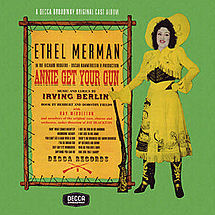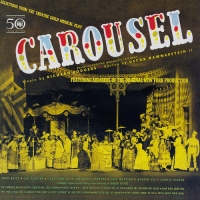
From Broadway To 52nd Street
Brigadoon opened at the Ziegfeld Theatre on March, 13, 1947 and had a run of 581 performances. Alan Jay Lerner and Frederick Leowe composed the music and lyrics for the stars David Brooks, Marion Bell, George Keane and Pamela Britton. From this musical arose to compositions to jazz standard fame – Almost Like Being In Love and The Heather On The Hill.
The Story: Two American hunters in Scotland lose their way and stumble upon the village of Brigadoon that seems to belong to another time. As they enter, a kilted swain is rejoicing his impending marriage. Tommy falls in love with Fiona, Jeff has a fling with Meg. They discover the village is bewitched coming back to life only once every hundred years. Jeff and Tommy flee but Tommy’s love for Fiona brings him back and the village appears just long enough to embrace him.
Broadway History: It was during the 20th century that the Tony Awards were established, in 1947. These awards recognized theater achievement in Broadway theaters. Other Broadway and theater awards include the Drama Desk Awards, New York Drama Critics Circle Award, Theatre World Awards and the Obie Awards. The Drama Desk Awards are the only award given to Broadway and off-Broadway productions, all competing against each other.
The Obie awards cover off Broadway and off-off Broadway productions. The Theatre World awards are given to actors for outstanding debut performances. The New York Drama Critics’ Circle award is the second oldest theater award in the U.S. with the main award for Best Play.
Sponsored By
www.whatissuitetabu.com

From Broadway To 52nd Street
St. Louis Woman opened on March 30, 1946 on the stage of the Martin Beck Theatre and ran for 113 performances. Harold Arlen composed the music and Johnny Mercer wrote the lyrics for the musical with one tune standing the test of time to become a jazz standard – Come Rain Or Come Shine. The original cast included Robert Pope, Harold Nicholas, Fayard Nicholas, June Hawkins, Pearl Bailey, Ruby Hill, Rex Ingram and Milton J. Williams.
The Story: Set in St. Louis in 1898, Little Augie, a jockey who is on a winning streak, is enamored with Della Green, the belle of St Louis. Della, however, is the girlfriend of abusive Bigelow Brown, the proprietor of the local bar. Decides to leave him, Brown’s previous mistress, Lila, is still around which produces complications.
It’s cakewalking time and Augie attracts the attention and admiration of Della with his virtuoso performance of the cakewalk. Things go so well between them that they agree to set up home together and prepare plans to marry. While Augie is off at the racetrack, Della gets an unwelcome visit from Biglow Brown who beats. Lila enters, begs for a reconciliation, Augie returns, shot is fired, curse is casted on Augie for the shot that in fact was fired by Lila.
At Brown’s funeral suspected Augie is exonerated by Lila’s confession but the curse seems to be working. His horses no longer win and Della blames herself for the troubles. Della leaves feigning no love for Augie but her new friend tells him her true feelings. Believing the curse to be so much mumbo-jumbo, he’ll win his next race and he and Della get back together again.
Jazz History: Charlie Parker began rising in prominence in the early 1940s, and he played frequently with bands led by Jay McShann, Earl Hines, and Billy Eckstine. In 1945, a young Miles Davis Miles Davis moved to New York and became intrigued with Parker and the emerging bebop style. He studied at Juilliard, but had trouble earning respect among jazz musicians because of his unrefined sound. Soon he would work his way into Parker’s quintet. In 1945, the term ‘moldy fig’ was coined to refer to swing musicians who were reluctant to accept that bebop was the new path of jazz development.
In the mid 1940s Charlie Parker began to deteriorate from drug use. He was admitted to Camarillo State Hospital after a breakdown in 1946. His stay there inspired the song “Relaxin’ at Camarillo”.
In 1947, tenor saxophonist Dexter Gordon achieved fame for recordings of “duels” with saxophonist Wardell Gray. Gordon’s virtuosity and aggressive tone attracted the attention of young alto saxophonist John Coltrane, who would shortly thereafter switch to tenor saxophone.
In 1948, Miles Davis and drummer Max Roach, fed up with Charlie Parker’s reckless lifestyle, left his band. Davis formed his own nonet. In 1949 recorded the unconventional ensemble. Some of the arrangements were by a young Gil Evans, and the restrained style of the music came to be known as cool jazz. The record, released almost a decade later, in 1957, was called Birth of the Cool.
By the end of the 1940s, bebop was the ideal among young jazz musicians. Unlike swing, bebop was untethered to popular demands. Its primary concern was musical advancement.
Sponsored By
www.whatissuitetabu.com

From Broadway To 52nd Street
Annie Get Your Gun rose its curtain for the first time at the Imperial Theatre on May 16, 1946. Irving Berlin composed the music for its stars Ethel Merman and Ray Middleton. The show set a record with a run of one thousand, one hundred and forty-seven performances. From the musical came three tunes that entered into the jazz lexicon – Anything You Can Do, There’s No Business Like Show Business and They Say It’s Wonderful.
The Story: Annie Oakley is poor but happy country girl and an infallible shot. This sharpshooting lands her in Buffalo Bill’s Wild West Show. She falls in love with rival sharpshooter Frank Butler, who tells her the girl that he marries must be a dainty thing, which Annie is not. It seems the only thing they can agree on is that when folks talk about love it’s wonderful. A shooting match is arranged between the two, Sitting Bull tells her that to win her man she must lose the match. Although Annie boast anything you can do I can do better, she loses the match anyway and the man.
Broadway History: Though Broadway was becoming less of an industry and more of a loose array of individuals, in the next four years this would have positive aspects. America would soon fall prey to increasing intolerance and political persecution but Broadway would continue to express unorthodox opinions without fear of government retaliation. Broadway would lose some of its scope but retain its liveliness and joyfulness in an increasing corporate environment. In a country that now required conformity, Broadway preserved a sense of freedom of speech and action, ideals on which this nation was founded. This was no less rewarded with the establishment of the private club of the “blockbuster musical” has offered entry to only a chosen few that have had more than a thousand performances. The first to join this esteemed club is this weeks feature Annie Get Your Gun.
Sponsored By
www.whatissuitetabu.com

From Broadway To 52nd Street
The Majestic Theatre opened the curtain for Carousel for the first time on April 19, 1945. With music composed by Richard Rodgers and Oscar Hammerstein, the musical ran for eight hundred and ninety performances. John Raitt and Jan Clayton had the title roles in this play adapted from the famous Molnar story of Liliom, from which came two songs that would endear themselves for years as jazz standards – What’s The Use Of Won’drin’ and If I Loved You.
The Story: Billy Bigelow, a shy New England carnival barker falls in love with Julie Jordan. Eventually winning Julie’s heart, he later discovers she is pregnant. Jobless, Billy decides he must provide for his son, or daughter, he agrees to join his criminal friend Jigger Craig in a robbery to earn extra money. The plan misfires and Billy kills himself rather than being caught. Before a heavenly judge he pleads for another chance to return to earth to earn his redemption and see his daughter. When his daughter refuses his gift of a star he has stolen from the sky, he slaps her and returns to purgatory. The widowed Julie and child are left to continue to live starkly. The story is set in Maine where majestic backdrops add emotional emphasis.
Jazz History: It was known simply as The Street and as historian Arnold Shaw stated in his book 52nd Street, “If you flagged a taxi in NYC and asked to be taken to The Street, you would be driven, without giving a number or an avenue, to Fifty-Second Street between Fifth and Sixth Avenues” By the late 1940s, as the jazz clubs turned into strip joints, many bemoaned the death of The Street. They considered this era to be the block’s decline.
In 1948, Time magazine decried the change from jazz to bump-n-grind: “where nightclubs in sorry brownstones crowd each other like bums on a breadline”, an era was all but over. Swing was still there, but it was more hips than horns. Barrelhouse had declined and burlesque was back. There was little jazz left on 52nd Street and even the customers had changed. There were fewer crew haircuts, pipes and sports jackets and more bald spots, cigars and paunches.
Sponsored By
www.whatissuitetabu.com

From Broadway To 52nd Street
Lady In The Dark took the stage at the Alvin Theatre on January 23, 1941. The musical starred Gertrude Lawrence, McDonald Carey, Dianne Kaye and Victor Mature with the music composed by Kurt Weill and lyrics by Ira Gershwin. It ran for four hundred and sixty-seven performances. Beyond its Broadway run, Lady In The Dark would b staged in the United Kingdom in 1981, was also made into a 1944 film and a live 1954 television special. Except for the final song, all the music in the play is heard in three extended dream sequences: the Glamour Dream, the Wedding Dream, and the Circus Dream which, to some extent, become three small operettas integrated into a straight play. The final song, “My Ship”, which went on to become a jazz standard, functioned as a leitmotif for Liza’s insecurity: as each dream commences, a snippet of the tune is heard, as it is a haunting melody which Liza recognizes but cannot name, or sing with words, until her anxiety is resolved.
The Story: The protagonist, Liza Elliott, is the unhappy albeit successful editor of a fashion magazine, Allure, who is undergoing psychoanalysis. Relating a dream to her analyst, all the familiar male figures in her life appear in her dream but they act in unfamiliar ways. By recounting her dream, Liza realizes that her father’s disdain for her as a child has warped her relations with men.
Broadway History: Innovations to Broadway would come in 1943 with Rodgers & Hammerstein’s Oklahoma, which integrated music, song, and dance with a detailed plot. West Side Story followed in these footsteps in 1957 by introducing serious themes, causing the genre to be called simply “musicals”. In 1967 Hair would herald the rock musical to prominence.
Sponsored By
www.whatissuitetabu.com


